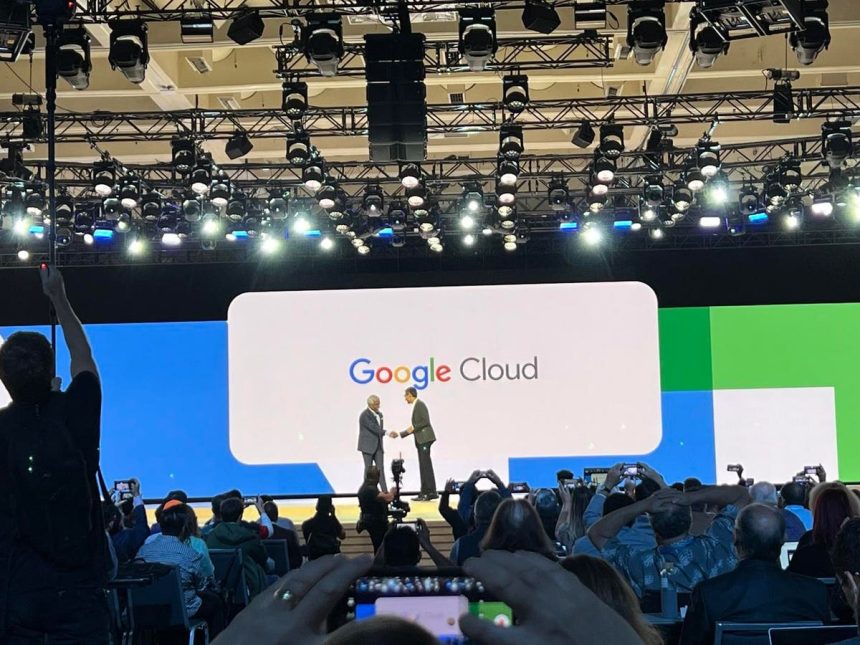Google Cloud Next 2023 took place in San Francisco last week, and it’s clear Google is feeling the heat when it comes to generative AI. The company announced a range of services and upgrades coming down the line for enterprise teams and developers, some of which are already generally available. Keep reading for some of the highlights:
Google unveils Duet AI for Google Workspace
Perhaps one of the biggest announcements at Google Cloud Next was the unveiling of Duet AI for Google Workspace. This is Google’s response to Microsoft 365 Copilot, which has gotten a lot of buzz since it was unveiled earlier this year. Much like Copilot, Duet AI seems focused on enhancing enterprise productivity. For instance, using Duet AI’s “attend for me” option in Google Meet, users can have Duet AI attend meetings, share pertinent messages, take notes, and create action items. If you join a meeting late, you can even request a “summary so far” to catch up. Similar to 365 Copilot, Duet AI will also be able to craft summaries of information throughout Google Workspace, including Gmail and Drive, as well as help creating content for emails and chats. For the average enterprise worker, Duet AI could improve productivity and free up hours of time to work on something else.
On the developer side, Duet AI can now help with code refactoring, which is essentially improving code without changing the code’s overall behavior. It can also help design and publish APIs from natural language prompts via connectors in Aigee, Google’s API management platform. And while this might not be something that the average person needs, this is a great feature for those knee deep in complex lines of code.
It will be interesting to watch if the race to general availability (GA) for various generative AI capabilities will drive any market share gains. When Microsoft launched Bing with Chat GPT there were a lot of eyes watching on whether material market share would move away from Google. Similarly, here, with Duet hitting GA before Copilot, will companies pivot off of Office365? Early indicators is that getting to GA first isn’t materially shifting market share, but it is winning hearts of current customers and certainly reducing the likelihood of attrition.
Upgrades and improvements throughout Vertex AI
Outside of the Duet AI for Google Workspace announcement, Google’s focus was on upgrading and improving Vertex AI generative AI platform–i.e. making Vertex AI more competitive. In my conversations with Thomas Kurian, Google Cloud CEO, he was steadfast in his belief that Vertex is a critical differentiator in the company’s strong growth around AI and has been highly contributive to the company’s strength in winning workloads from AI unicorns. Google shared that it has 70% of such unicorns as Google Cloud users.
For instance, Google increased the capacity for the PaLM foundation model from 4,000 to 32,000 tokens, allowing customers to input 8x more content than previous iterations. They also added new languages for Vertex AI, growing up to 38 for public use and 100 for private use. These include Arabic, Chinese, Spanish, German, and Japanese.
Two previously available services have also been renamed, revamped and added to Vertex AI; Search and Conversation. Vertex AI Search, available now, allows you to create a search engine for your own business data. Vertex AI Conversation is a tool for chatbot building.
Also noteworthy, Vertex text-to-image will now allow for “style tuning” to help mimic company brand and creative guidelines. Just drop 10 reference images, and Vertex AI will do the rest.
A3 virtual machine supercomputing with NVIDIA
In addition to announcements with Google Duet AI and Vertex AI, Google also announced the development of A3 virtual machine supercomputing capabilities via partnership with NVIDIA’s H100 GPUs. The A3, which powers AI training and scaling, will offer 10x more bandwidth than the previous A2 model, with training that is 3x faster. This next-gen A3 GPU supercomputer was actually announced via private preview back in May. It is expected to be generally available starting sometime this month. That is, if Google can keep up with demand. Nvidia’s H100 GPUs, at a price point of $30,000+, have been backordered due to their popularity. This announcement should have been expected by most as NVIDIA has found itself the most popular partner at every tech event in 2023—a clear indicator of how strong demand is for GPUs and NVIDIA’s clear market leading position in AI at this juncture.
Google announces TPU v5e for generative AI inference
Also on the development side, Google announced the fifth generation of cloud tensor processing units (TPUs), a machine learning accelerator of Google Cloud. This feature handles data needed for making inferences, which are needed for AI prediction-making. The upgrade is all about performance and cost efficiency. Google says the v5e is twice as fast per dollar of training and 2.5 better at inference per dollar than its successor. It will be interesting to watch the evolution of Google designed silicon. As the world is watching NVIDIA, there should be massive growth in adoption of homegrown silicon from companies like Google, Microsoft, and AWS, all of which will be seeking ways to design and deliver silicon for AI that may offer both cost and power efficiencies.
Google Kubernetes Engine (GKE) Enterprise Edition
In addition to the announcements above, GKE is also getting an upgrade. The new enterprise edition will offer–once again–cost and performance efficiencies with customers showing productivity gains of up to 45 percent and reduced software deployment times of 70+ percent. GKE Enterprise Edition will also be available in September.
Generative AI: Looking forward
Google’s Duet AI announcement was most likely the most exciting drop of Google Cloud Next 23, at least from the overall Google user/enterprise perspective. It shows that we are in fact at a spot where generative AI is becoming increasingly available for productivity and enterprise with Google, Microsoft, IBM, Salesforce, Adobe, and so many large technology companies delivering services and capabilities as a service—making consumption easier and time to value more immediate.
The question now is: what next? Clearly Google is putting in time to improve its current generative AI systems with GKE, v5e, and A3 so that generative AI can be modeled and scaled more quickly and efficiently. And as the technology industry is rapidly delivering new generative AI solutions to market at scale, it further raises questions about where to place the guardrails on AI advancement. The technology–and tech companies–are moving faster than any government or global oversight can comprehend. And the advancements aren’t incremental–they’re leaps of 2x and 10x the efficiencies. I stand by my belief that regulation will come in arrears as it always does with technology and of course there are real risks associated with the rapid adoption of AI and generative AI solutions—but policymakers and governments won’t be able to keep up and the industry will be required to self-regulate or at least attempt to do so. Nevertheless, Google and its peers are moving at a breakneck pace to make AI a reality for consumer and business applications. It’s an incredibly exciting time to enable efficiency and productivity from these tools and Google Cloud Next was another moment of many to come where AI will be prominently on display.
Read the full article here










